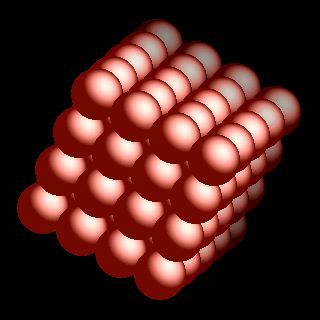| Noun | 1. | atomic number 90 - a soft silvery-white tetravalent radioactive metallic element; isotope 232 is used as a power source in nuclear reactors; occurs in thorite and in monazite sands thorium, Th metal, metallic element - any of several chemical elements that are usually shiny solids that conduct heat or electricity and can be formed into sheets etc. radiothorium, thorium-228 - radioactive isotope of thorium with mass number 228 monazite - a reddish-brown mineral containing rare earth metals; an important source of thorium and cerium thorite - a radioactive mineral consisting of thorium silicate; it is a source of thorium that is found in coarse granite |
A table of the elements sorted by atomic number. Home Jobs News & Articles. Atomic Number 90. Atomic Number 91. The atomic number of the thorium isotope, 90, will be decreased by 2 for each alpha emission and increased by 1 for each beta emission, so find the atomic number of the stable daughter product by subtracting from the atomic number 2 times the number of emitted alphas, 6, and adding 1 times the number of emitted betas, 4.
Want to thank TFD for its existence? Tell a friend about us, add a link to this page, or visit the webmaster's page for free fun content.Link to this page:
How big is an atom? A simple question maybe, but the answer is not at all straighforward. To a first approximation we can regard atoms as 'hard spheres', with an outer radius defined by the outer electron orbitals. However, even for atoms of the same type, atomic radii can differ, depending on the oxidation state, the type of bonding and - especially important in crystals - the local coordination environment.
Take the humble carbon atom as an example: in most organic molecules a covalently-bonded carbon atom is around 1.5 Ångstroms in diameter (1 Ångstrom unit = 0.1 nanometres = 10-10 metres); but the same atom in an ionic crystal appears much smaller: around 0.6 Ångstroms. In the following article we'll explore a number of different sets of distinct atomic radius sizes, and later we'll see how you can make use of these 'preset' values with CrystalMaker.
What Is Atomic Number 90
Atomic Radii
Atomic radii represent the sizes of isolated, electrically-neutral atoms, unaffected by bonding topologies. The general trend is that atomic sizes increase as one moves downwards in the Periodic Table of the Elements, as electrons fill outer electron shells. Atomic radii decrease, however, as one moves from left to right, across the Periodic Table. Lego batman 2 mac download free. Although more electrons are being added to atoms, they are at similar distances to the nucleus; and the increasing nuclear charge 'pulls' the electron clouds inwards, making the atomic radii smaller.
Atomic radii are generally calculated, using self-consistent field functions. CrystalMaker uses Atomic radii data from two sources:
VFI Atomic Radii:
Vainshtein BK, Fridkin VM, Indenbom VL (1995) Structure of Crystals (3rd Edition). Springer Verlag, Berlin.CPK Atomic Radii:
Clementi E, Raimondi DL, Reinhardt WP (1963). Journal of Chemical Physics 38:2686-
Covalent Radii
The covalent radius of an atom can be determined by measuring bond lengths between pairs of covalently-bonded atoms: if the two atoms are of the same kind, then the covalent radius is simply one half of the bond length.
Whilst this is straightforward for some molecules such as Cl2 and O2, in other cases one has to infer the covalent radius by measuring bond distances to atoms whose radii are already known (e.g., a C--X bond, in which the radius of C is known).
CrystalMaker uses covalent radii listed on CrystalMaker-user Mark Winter's excellent Web Elements website.
Van-der-Waals Radii
Van-der-Waals radii are determined from the contact distances between unbonded atoms in touching molecules or atoms. CrystalMaker uses Van-der-Waals Radii data from:
Bondi A (1964) Journal of Physical Chemistry 68:441-
Atomic-Ionic Radii
These are the 'realistic' radii of atoms, measured from bond lengths in real crystals and molecules, and taking into account the fact that some atoms will be electrically charged. For example, the atomic-ionic radius of chlorine (Cl-) is larger than its atomic radius.
The bond length between atoms A and B is the sum of the atomic radii,

dAB = rA + rB
CrystalMaker uses Atomic-Ionic radii data from:
Slater JC (1964) Journal of Chemical Physics 39:3199-
Atomic Number 90 Electron Configuration
Crystal Radii
Perhaps the most authoritative and highly-respected set of atomic radii are the 'Crystal' Radii published by Shannon and Prewitt (1969) - one of the most cited papers in all crystallography - with values later revised by Shannon (1976). These data, originally derived from studies of alkali halides, are appropriate for most inorganic structures, and provide the basis for CrystalMaker's default Element Table. The data are published in:
Shannon RD Prewitt CT (1969) Acta Crystallographica B25:925-946
Shannon RD (1976) Acta Crystallographica A23:751-761
The Colours of Atoms
Colour-coding atoms by element type is an important way of representing structural information. Of course, atoms don't have 'colour' in the conventional sense, but various conventions have been established in different disciplines.
Many organic chemists use the so-called CPK colour scheme These colours are derived from those of plastic spacefilling models developed by Corey, Pauling and (later improved on by) Kultun ('CPK').
Element With The Atomic Number 90
Whilst the standard CPK colours are limited to the elements found in organic compounds, CrystalMaker's VFI Atomic Radii, CSD Default Radii and Shannon & Prewitt Crystal Radii Element Tables provide a more diverse range of contrasting colours.
Atom With Atomic Number 90
Organic Structures Alert! CrystalMaker's default Element Table is the Shannon & Prewitt 'Crystal' radii, which is appropriate for most inorganic structures. When working with organic structures, one of the covalent or Van-der-Waals sets will be more appropriate.
